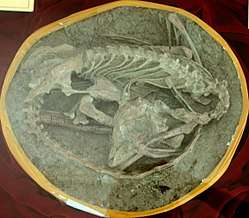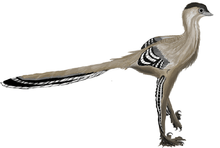Mei long
| Mei long | |
|---|---|
 | |
| Fossil specimen | |
| Scientific classification | |
| Kingdom: | Animalia |
| Phylum: | Chordata |
| Clade: | Dinosauria |
| Order: | Saurischia |
| Suborder: | Theropoda |
| Family: | †Troodontidae |
| Subfamily: | †Sinovenatorinae |
| Genus: | †Mei Xu & Norell, 2004 |
| Species: | †M. long |
| Binomial name | |
| Mei long Xu & Norell, 2004 | |
Mei (from Chinese 寐 mèi to sleep soundly) is a genus of duck-sized troodontid dinosaur first unearthed by paleontologists in Liaoning, China in 2004. Mei lived during the Early Cretaceous Period. The binomial name of its only species, Mei long (Chinese 寐 mèi and 龍 lóng) means sleeping dragon.
Description


Mei is a troodontid, a group of small, bird-like, gracile maniraptorans. All troodontids have many unique features of the skull, such as closely spaced teeth in the lower jaw, and large numbers of teeth. Troodontids have sickle-claws and raptorial hands, and some of the highest non-avian encephalization quotients, meaning they were behaviourally advanced and had keen senses.[1] The type fossil is a young juvenile about 53 centimetres (21 in) long, complete and exceptionally well preserved in three-dimensional detail, with the snout nestled beneath one of the forelimbs and the legs neatly folded beneath the body, similar to the roosting position of modern birds. This posture provides another behavioral link between birds and dinosaurs.[2] The chemistry of the matrix stone and the resting pose indicate the living animal was probably buried instantly in volcanic ash. A second specimen, DNHM D2154, was also preserved in a sleeping posture.[3]
Mei is notable as a distinct species of troodontid based on several unique features, including extremely large nares. It is most closely related to the troodontid Sinovenator, which places it near the base of the troodontid family.[2]
As a basal troodontid, unlike advanced troodontids, it has a bird like hip structure shared with many advanced maniraptorans.
See also
References
- ↑ Junchang Lü; Li Xu; Yongqing Liu; Xingliao Zhang; Songhai Jia & Qiang Ji (2010). "A new troodontid (Theropoda: Troodontidae) from the Late Cretaceous of central China, and the radiation of Asian troodontids" (PDF). Acta Palaeontologica Polonica. 55 (3): 381–388. doi:10.4202/app.2009.0047.
- 1 2 Xing Xu & Mark A. Norell (2004). "A new troodontid dinosaur from China with avian-like sleeping posture". Nature. 431 (7010): 838–841. doi:10.1038/nature02898. PMID 15483610. Retrieved 2012-10-20.
- ↑ Gao, C.; Morschhauser, E. M.; Varricchio, D. J.; Liu, J.; Zhao, B. (2012). Farke, Andrew A, ed. "A Second Soundly Sleeping Dragon: New Anatomical Details of the Chinese Troodontid Mei long with Implications for Phylogeny and Taphonomy". PLoS ONE. 7 (9): e45203. doi:10.1371/journal.pone.0045203. PMC 3459897. PMID 23028847.
External links
- Mei long at the American Museum of Natural History
